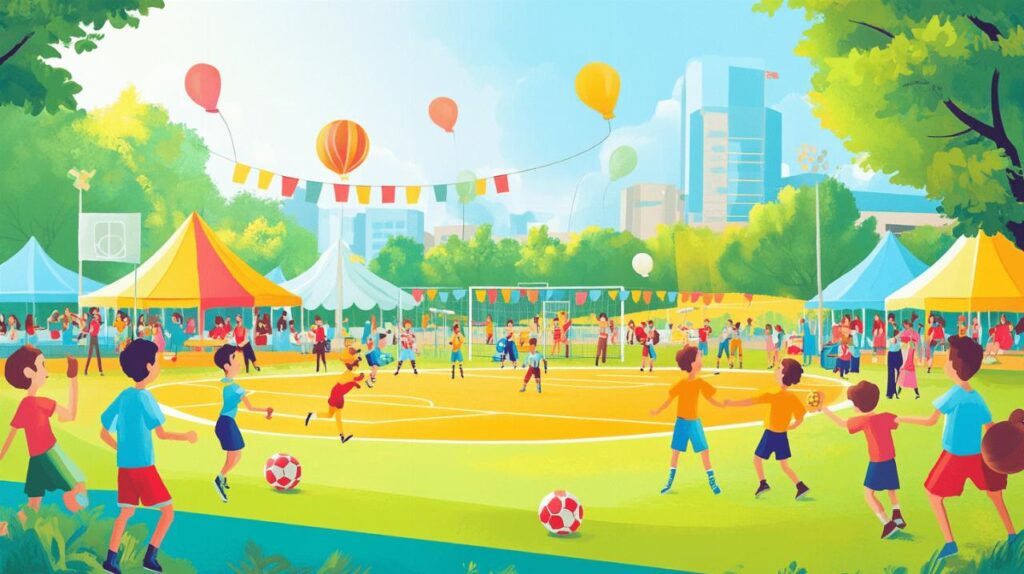Planning a successful children's sports tournament involves more than just gathering young athletes together on a field. It requires meticulous preparation, appropriate equipment, and thoughtful organisation to ensure the event runs smoothly and safely. Whether you're a coach, school administrator, or parent volunteer, this comprehensive guide will help you navigate the essentials of organising a memorable sports tournament for children.
Gathering the necessary equipment
The foundation of any successful sports tournament is having the right equipment on hand. The experts at Club Deportivo Sapporo recommend creating a comprehensive checklist well in advance of your event to ensure nothing is overlooked. Proper sports equipment organisation is crucial not only for the smooth running of the tournament but also for maintaining safety standards throughout the competition.
Sport-specific gear requirements
Different sports naturally require different equipment. For football tournaments, you'll need properly sized footballs appropriate for the age group, goal posts, corner flags, and whistles for referees. Basketball events require regulation hoops, scoreboards, and appropriately sized basketballs. When organising multi-sport tournaments, colour-coding equipment can help volunteers and participants quickly identify which gear belongs to which sport, making sports gear management more efficient during transitions between games.
Consider investing in free-standing storage units that can be transported to the venue for organised access to various-sized balls, bats, and other sport-specific equipment. Wall-mounted ball holders can also be installed at permanent venues to keep larger balls secure yet accessible. For tournaments involving multiple teams, having sufficient quantities of numbered or coloured bibs or vests is essential for team identification.
First-aid and safety equipment checklist
Safety must always be your primary concern when hosting youth sports events. A comprehensive first-aid station should include ice packs, bandages, antiseptic wipes, adhesive plasters in various sizes, and emergency contact information for all participants. Based on recommendations from safety experts, tournament organisers should also ensure access to an automated external defibrillator (AED) and have staff trained in its use.
Beyond medical supplies, safety equipment specific to each sport should be readily available. This includes protective gear such as helmets for cricket or baseball, shin guards for football, and appropriate padding for contact sports. Creating a game day quick grab station with essential safety items ensures that emergency response can be swift and efficient should the need arise.
Creating a structured tournament schedule
The success of a children's sports tournament often hinges on thoughtful sports tournament planning. A well-structured schedule prevents chaos and ensures all teams receive fair playing time. Begin by determining the format of your tournament—knockout, round-robin, or a combination—as this will dictate how many matches each team plays and the overall duration of the event.
Allocating appropriate match times and rest periods
When scheduling matches for young athletes, it's essential to consider their stamina and attention spans. Shorter match durations are typically more appropriate for younger children, with rest periods scheduled between games. Experts recommend at least 15-20 minutes of recovery time between matches for children to rehydrate and recuperate. This is particularly important in multi-day tournaments where fatigue can accumulate.
Digital platforms can be invaluable for creating and sharing tournament schedules. Many tournament management applications allow for real-time updates, notifying participants of any changes due to weather or other circumstances. Having a printed schedule on display at information points around the venue is also recommended as a backup system that everyone can easily access.
Venue planning and space management
Efficient use of available space is crucial when hosting multiple matches simultaneously. Multi Use Games Areas (MUGAs) offer versatility for different sports and can be adapted to suit tournament needs. When designing your venue layout, ensure there's adequate space between playing areas to prevent balls or players from one match interfering with another.
Consider designating specific zones for teams waiting for their next match, spectator viewing areas, and refreshment stations. These designated areas help maintain order and improve the overall experience for all attendees. Using outdoor storage bins for equipment at each playing area helps keep the venue organised and reduces the risk of equipment being misplaced during the tournament.
Implementing robust safety measures
Safety must be the cornerstone of any children's sports tournament. Beyond having the right safety equipment, implementing comprehensive safety protocols and ensuring proper supervision are essential steps in risk management for youth sports events.
Training and positioning first aid personnel
Having qualified first aid personnel is non-negotiable for children's sports tournaments. These individuals should be easily identifiable, perhaps wearing distinctive uniforms or vests, and stationed strategically throughout the venue. For larger tournaments, consider having a central first aid station supplemented by mobile first aiders who can quickly respond to incidents on any playing field.
First aid personnel should be briefed on common sports injuries relevant to the tournament's activities. They should also have access to each participant's medical information, including allergies or pre-existing conditions that might require special attention. Creating clear pathways for emergency vehicles to access all parts of the venue is another critical safety consideration that should be addressed during the planning phase.
Establishing clear safety protocols for participants
Before the tournament begins, all participants should be briefed on safety rules and expectations. This includes proper warm-up procedures, which can significantly reduce the risk of injury. Using outdoor gym equipment for supervised stretching and cardio exercises provides an effective way to prepare young athletes for competition.
Weather-related safety protocols are equally important. Establish clear guidelines for extreme heat, cold, or stormy conditions, including criteria for postponing or cancelling matches. Participants should also understand the importance of staying hydrated and recognising the signs of heat exhaustion or other weather-related health concerns.
Effective communication strategies
 Clear communication before, during, and after the tournament ensures that all stakeholders—participants, parents, volunteers, and officials—are well-informed and can contribute to the event's success. A comprehensive communication plan addresses everything from pre-tournament information to real-time updates during the event.
Clear communication before, during, and after the tournament ensures that all stakeholders—participants, parents, volunteers, and officials—are well-informed and can contribute to the event's success. A comprehensive communication plan addresses everything from pre-tournament information to real-time updates during the event.
Utilising Digital Platforms for Updates and Announcements
In today's digital age, leveraging technology for tournament communications offers numerous advantages. Create a dedicated event page or website where participants can find all relevant information in one place. Email newsletters provide an effective way to distribute important updates leading up to the tournament, while messaging apps can facilitate more immediate communication among organisers and volunteers.
Social media platforms offer additional channels for sharing tournament highlights, results, and changes to the schedule. Consider creating a tournament-specific hashtag to encourage participants and spectators to share their experiences online. This not only enhances the community aspect of the event but also provides valuable content that can be used to promote future tournaments.
Creating information points at tournament venues
Despite the convenience of digital communication, physical information points remain essential at tournament venues. These stations should be clearly marked and staffed by knowledgeable volunteers who can answer questions and provide directions. Giant whiteboard play panels displaying brackets or league tables help participants and spectators track tournament progress at a glance.
Loudspeaker announcements are effective for communicating important information to everyone at the venue simultaneously. However, they should be used judiciously to avoid creating an environment that's too noisy or distracting for participants. For complex venues with multiple playing areas, consider providing maps that clearly mark the locations of playing fields, restrooms, first aid stations, and refreshment areas.
Building a reliable volunteer team
No children's sports tournament can succeed without dedicated volunteers. From refereeing matches to managing registration tables, volunteers are the backbone of youth sports events. Building a strong volunteer team requires careful recruitment, clear role definitions, and effective management strategies.
Roles and Responsibilities for Volunteer Officials
Official roles such as referees, scorekeepers, and timekeepers require specific knowledge and, in some cases, certification. Identify these needs early in your planning process and recruit individuals with appropriate experience. Providing training sessions before the tournament ensures that all officials understand the rules and procedures specific to your event.
Create detailed job descriptions for each official role, including specific responsibilities and time commitments. This clarity helps volunteers understand what's expected of them and reduces the likelihood of miscommunication during the tournament. Consider pairing less experienced volunteers with veterans to facilitate on-the-job learning and build confidence.
Recruiting and managing parent volunteers
Parents of participating children often represent the largest pool of potential volunteers. When recruiting parent volunteers, be specific about the help you need and the time commitment involved. Many parents are happy to contribute but need to know exactly what they're signing up for. Family sports organisation often benefits from parents taking active roles in their children's activities.
Assign volunteer coordinators to manage groups of volunteers, ensuring that everyone knows when and where they're needed. These coordinators can also serve as the first point of contact for questions or concerns from their team. Showing appreciation for volunteer efforts—through public acknowledgment, thank-you notes, or small tokens of gratitude—helps build a positive volunteer culture that encourages continued involvement.
Weather contingency planning
Weather is perhaps the most unpredictable factor in outdoor sports tournaments. Having robust contingency plans for adverse weather conditions is essential for minimising disruption and ensuring participant safety. These plans should address various scenarios, from light rain to severe weather events that necessitate significant changes to the tournament format.
Alternative indoor venue arrangements
Identify potential indoor facilities that could host your tournament in case of severe weather. This might include local school gymnasiums, sports halls, or community centres. Establish relationships with the managers of these facilities well in advance and understand their availability and booking procedures for last-minute changes.
When selecting indoor alternatives, consider whether they can accommodate the same number of teams and spectators as your outdoor venue. You may need to adjust the tournament format or schedule to fit the constraints of an indoor space. Having pre-designed alternative formats ready to implement saves valuable time if a last-minute venue change becomes necessary.
Adapting tournament format for adverse conditions
Not all weather issues require moving indoors. For light rain or moderate wind, the tournament might continue with some adaptations. These could include shortened match durations, more frequent breaks, or modified rules that account for slippery playing surfaces. Seasonal equipment storage considerations become particularly important when weather conditions might deteriorate, requiring quick access to weather-appropriate gear.
Communication is crucial when implementing weather-related changes. Ensure all participants, volunteers, and spectators are promptly informed of any adjustments to the schedule or format. Having a clear decision-making protocol—including who has the authority to delay or cancel matches and the criteria for these decisions—helps avoid confusion during challenging weather situations.

